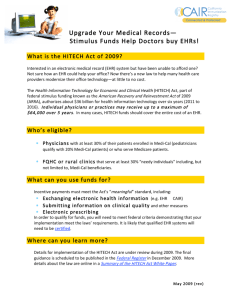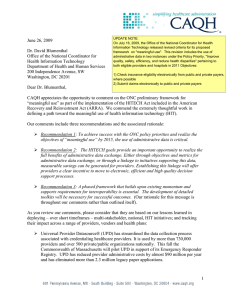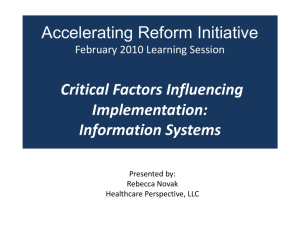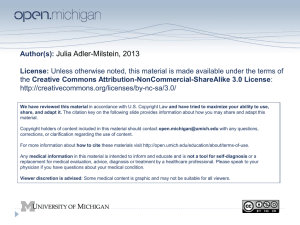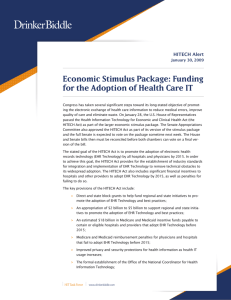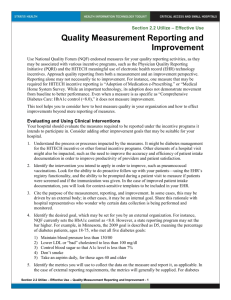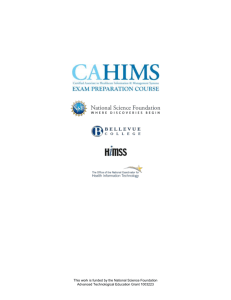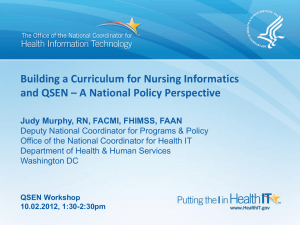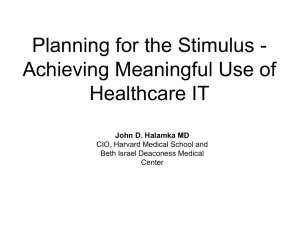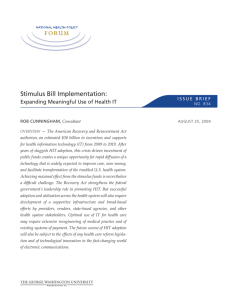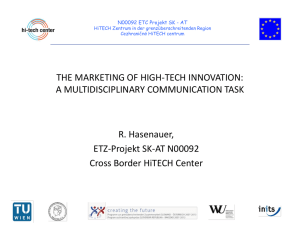What is HITECH?
advertisement
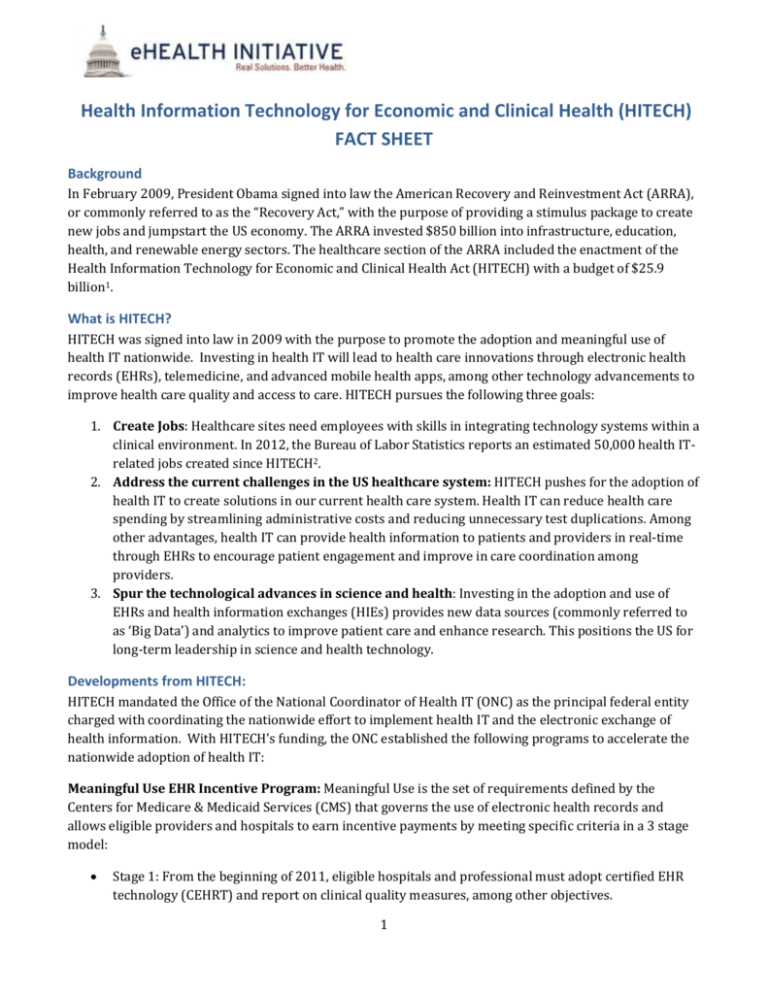
Health Information Technology for Economic and Clinical Health (HITECH) FACT SHEET Background In February 2009, President Obama signed into law the American Recovery and Reinvestment Act (ARRA), or commonly referred to as the “Recovery Act,” with the purpose of providing a stimulus package to create new jobs and jumpstart the US economy. The ARRA invested $850 billion into infrastructure, education, health, and renewable energy sectors. The healthcare section of the ARRA included the enactment of the Health Information Technology for Economic and Clinical Health Act (HITECH) with a budget of $25.9 billion1. What is HITECH? HITECH was signed into law in 2009 with the purpose to promote the adoption and meaningful use of health IT nationwide. Investing in health IT will lead to health care innovations through electronic health records (EHRs), telemedicine, and advanced mobile health apps, among other technology advancements to improve health care quality and access to care. HITECH pursues the following three goals: 1. Create Jobs: Healthcare sites need employees with skills in integrating technology systems within a clinical environment. In 2012, the Bureau of Labor Statistics reports an estimated 50,000 health ITrelated jobs created since HITECH2. 2. Address the current challenges in the US healthcare system: HITECH pushes for the adoption of health IT to create solutions in our current health care system. Health IT can reduce health care spending by streamlining administrative costs and reducing unnecessary test duplications. Among other advantages, health IT can provide health information to patients and providers in real-time through EHRs to encourage patient engagement and improve in care coordination among providers. 3. Spur the technological advances in science and health: Investing in the adoption and use of EHRs and health information exchanges (HIEs) provides new data sources (commonly referred to as ‘Big Data’) and analytics to improve patient care and enhance research. This positions the US for long-term leadership in science and health technology. Developments from HITECH: HITECH mandated the Office of the National Coordinator of Health IT (ONC) as the principal federal entity charged with coordinating the nationwide effort to implement health IT and the electronic exchange of health information. With HITECH’s funding, the ONC established the following programs to accelerate the nationwide adoption of health IT: Meaningful Use EHR Incentive Program: Meaningful Use is the set of requirements defined by the Centers for Medicare & Medicaid Services (CMS) that governs the use of electronic health records and allows eligible providers and hospitals to earn incentive payments by meeting specific criteria in a 3 stage model: Stage 1: From the beginning of 2011, eligible hospitals and professional must adopt certified EHR technology (CEHRT) and report on clinical quality measures, among other objectives. 1 Stage 2: Set to begin in 2014, the objectives focus on enabling health information exchange (HIE) and advancing clinical processes of EHRs. Stage 3: Starting in 2016, stage 3 focuses on improving health outcomes and population health management. Final publication on objectives and times are currently being deliberated. ONC HIT Certification Program: The HITECH Act charged ONC with selecting the standards and certification criteria for EHRs. The program provides a defined process to ensure that EHR technologies meet the standards and certification criteria to help providers and hospitals achieve Meaningful Use objectives. Once the product is certified, the ONC posts the approved products to the Certified Health IT Product list (CHPL). Regional Extension Centers (RECs): RECs provide education, EHR support, and technical assistance in implementing health IT and using it in a meaningful way for individual and small practices lacking the resources to keep up with the changing environment. The ONC funds 62 RECs with a budget of $677 million to support their work. Federal Advisory Committees: The Federal Advisory Committee Act (FACA) under the ARRA, provided for the creation of two committees to provide multi-stakeholder recommendations to the ONC regarding the development and adoption of nationwide health IT infrastructure. The two committees are: Health IT Policy Committee (HITPC): Appointed members collaborate to make recommendations to ONC on a policy framework for health IT. The HITPC itself is composed of many workgroups, including meaningful use, information exchange, privacy & security, quality measures, and others. Health IT Standards Committee (HITSC): Appointed members collaborate to make recommendations on standards, implementation specifications, and certification criteria for the electronic exchange of health information. HITSC is also composed of many workgroups, including Clinical Operations, Implementation, and Nationwide Health Information Network (NwHIN) power team, and others. Beacon Community Program: The program consists of 17 selected communities, spanning the nation charged with demonstrating how health IT investments and the meaningful use of EHRs can provide higher quality and efficiency in the delivery of health care. The ONC provided $250 million spread among the 17 communities to strengthen their health IT infrastructure and provide a series of measureable outcomes and lessons learned for the nation to look at for evidence-based health IT implementation. State Health Information Exchange (State HIE): In March 2010, ONC funded states’ efforts to rapidly build capacity for exchanging health information across the health care system both within and across states. How Can I Learn More? The eHealth Initiative (eHI) provides up-to-date news on HITECH program developments in our weekly newsletter as well as summaries and blog posts for HITPC and HITSC meetings. For more information on HITECH programs, policy summaries, and other eHealth topics, check out the eHI Resource Center on our website at www.ehidc.org. 1 2 HHS Information Related to the ARRA <http://www.hhs.gov/recovery> CMS Fact Sheets: “A Record of Progress on Health Information Technology.” April 23, 2012. 2
